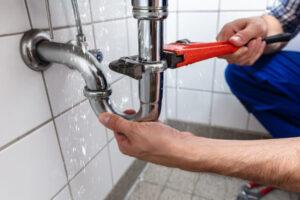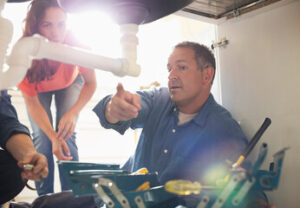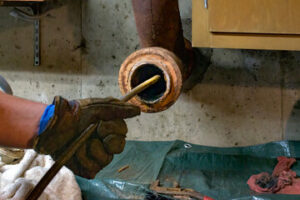Plumber Topeka deal with water, sewage, and gas systems. Every building and house requires these services to function properly.
A licensed apprentice is a beginner-level plumber who works under the supervision of a journeyman plumber. These professionals usually undergo four years of apprenticeship training consisting of on-the-job experience and technical courses.

A plumber installs and repairs water supply lines, drainage systems, toilets, fixtures, and appliances in homes and businesses. They also inspect and maintain plumbing systems and components to ensure they function properly and comply with regulatory codes. Additional duties may include:
- Installing sump pumps and sewage ejector systems.
- Testing water pressure levels.
- Fixing leaks.
- Unblocking drains.
- Designing plumbing systems.
Plumbers need to be physically strong and able to work in tight spaces. They must also be able to lift heavy equipment and tools. They should be able to read and interpret blueprints and building specifications. Plumbers must also have excellent communication skills to relay instructions to assistants, customers, managers, and other construction professionals. They must also be able to explain complex ideas and processes in easy-to-understand ways.
A commercial plumber installs, repairs, and maintains plumbing systems in schools, hospitals, manufacturing plants, office buildings, warehouses, and other large facilities. They also inspect and test water, gas, and steam supply lines to ensure they are safe. These professionals often specialize in specific plumbing issues and are more advanced than residential plumbers.
Apprentice plumbers follow the directions of more experienced plumbers to learn their trade. They usually work small plumbing jobs and help senior plumbers with larger projects. They also need to be able to carry out basic tasks, such as cleaning and organizing tools.
Journeyman plumbers install, repair, and maintain a variety of pipes in both residential and commercial settings. They often use their skills to work with copper, PEX, and black iron piping. Other responsibilities include interpreting blueprints and drawings, assembling pipe sections, tubing, and fittings using clamps, screws, soldering, welding equipment, and caulking.
Senior plumbers are responsible for overseeing the work of assistant plumbers and apprentices. They also perform various other tasks, including preparing work areas, completing inspections and reports, and communicating with customers and other construction professionals. They must be able to solve complex problems quickly and accurately. They must also work well under pressure and adhere to strict safety regulations.
The qualifications to become a plumber vary by state, but most require a high school diploma or equivalent and formal training as an apprentice. Some vocational schools and community colleges offer certificate programs that can be completed in less than a year. Others may require two years to complete, including an internship. Applicants should also take an exam that tests their knowledge of plumbing systems, piping regulations, and local building codes. In addition to their technical skills, plumbers need excellent customer service skills. They must be able to work with their hands, troubleshoot problems, and create accurate client cost estimates.
Plumbers may find work with construction companies, plumbing contractors, or maintenance departments of commercial or residential buildings. They are also sometimes self-employed. The training required to become a licensed plumber includes on-the-job experience and classroom instruction. Plumbers must be able to read blueprints and understand backflow prevention devices. They are often called on to fix leaks and sewer backups and install water heaters, toilets, and fixtures.
To obtain a journeyman license, plumbers must have at least four years of experience working as an apprentice and pass an exam. Applicants must also submit a notarized affidavit from master plumbers who vouch for their work experience. Some states require a high school degree or GED, and others have additional education requirements for licensing.
Plumbers need good math and physics skills to calculate pipe sizes, materials, and cuts. They must also be able to read and follow blueprints and understand how to operate tools. They must have physical strength, flexibility, and good eyesight to work in cramped spaces and awkward positions. They are frequently exposed to hot, cold, and wet conditions and must wear protective gear to protect their bodies. They must also keep up with the latest advances in plumbing technology. To maintain their licenses, plumbers must attend continuing education courses to stay current on industry changes. They must also pass a criminal background check to receive their licenses.
A plumber’s work environment can be challenging. They are exposed to various chemicals and bacteria that can cause illness. They are also required to work in awkward positions that can put them at risk of injuries. They must be able to stand or crouch for long periods and lift heavy equipment. Plumbing is not a good career choice for people uncomfortable with hard manual labor.
A normal workday for a plumber starts with reviewing any job orders or schedules to determine what tasks they will need to complete and which tools and materials they will need to bring. Then, they will go to their work site. This can be in residential or commercial locations. The job sites can be very crowded and require plumbers to maneuver in tight spaces.
The rest of the day is spent working on plumbing jobs, including repairing and installing pipes, fixtures, and appliances. They also inspect sewer systems to ensure they are functioning properly and meet the standards of health codes and regulations. Plumbers also spend a lot of time calling clients to confirm appointments or letting them know they will be late for their scheduled appointments.
In addition, plumbers must be able to work around a wide variety of electrical equipment. They also need to be able to read and understand blueprints and drawings. Plumbers often work with other construction tradespeople, so they must be able to get along with others.
A career in plumbing can be very rewarding, but it is only for some. There are many different options for people wanting to become plumbers, so it is important to research all the requirements and qualifications before applying for a position. Those who are successful in this field can make a good living and enjoy a variety of job opportunities. It is possible to turn this career into a significant source of income, but it takes time and commitment to become a master plumber. Becoming a plumber can be very satisfying if you are willing to work hard and have the right qualities.
If you’re thinking of becoming a plumber, you’ll want to know how much you can expect to make. The good news is that plumbers do quite well in the job market and can earn a decent salary. On average, plumbers make about $50,000 a year.
However, this figure varies greatly depending on location, experience, and employer. For example, a plumber generally makes more money in cities with high living costs than in smaller towns where gas and food are cheaper.
If you’re looking to move to a new city, consider this when calculating how much you will need to earn in that area to make ends meet.
Those who choose to start their plumbing businesses can increase their salaries significantly by working hard and maintaining industry standards. However, this is only a career path for some and requires much work and dedication. In addition, you’ll need to invest a lot of time and effort into marketing your business and hiring quality employees.
The United Association offers a wide variety of resources that can help you learn more about the job duties and salary for plumbers, including information on vocational education, certification requirements, and job growth. You can also use free online tools to calculate your potential salary based on your education, training, and experience. You can even get a feel for the competitiveness of wages in different states and regions by using a database that contains wage information from thousands of employers.

